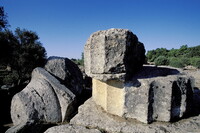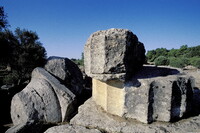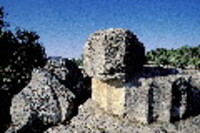| dc.coverage.spatial | Site: Olympia, Peloponnese, Greece | en_US |
| dc.coverage.temporal | ca. 470-456 BCE (creation) | en_US |
| dc.creator | Libon of Elis | en_US |
| dc.date | -470--456 | en_US |
| dc.date.accessioned | 2013-05-22T19:39:17Z | |
| dc.date.available | 2013-05-22T19:39:17Z | |
| dc.date.issued | -470--456 | en_US |
| dc.identifier | 220923 | en_US |
| dc.identifier.other | archrefid: 691 | en_US |
| dc.identifier.uri | http://hdl.handle.net/1721.3/128847 | |
| dc.description | The base of a fallen column on the south side of the temple; The Temple of Zeus, in the middle of the Altis, was begun ca. 470 BCE and completed in 456 BCE. This Doric peripteral temple (27.68 x 64.12 m; 6 x 13 columns) was the work of the Elian architect Libon. The largest temple in the Peloponnese, it was considered the finest expression and the 'canon' of the Doric order. It was constructed of local shelly limestone covered with white stucco, with only the roof, sima and lion-head waterspouts of Parian marble. Later, the frequent local earthquakes made replacements of Pentelic marble necessary. The marble pedimental groups are among the finest examples of Early Classical sculpture. Source: Grove Art Online; http://www.groveart.com/ (accessed 11/4/2007) | en_US |
| dc.format.medium | stone; shell limestone; stucco; marble | en_US |
| dc.rights | © Scott Gilchrist, Archivision, Inc. | en_US |
| dc.subject | architectural exteriors | en_US |
| dc.subject | deities | en_US |
| dc.subject | mythology (Classical) | en_US |
| dc.subject | Early Classical | en_US |
| dc.title | Olympia: Temple of Zeus | en_US |
| dc.title.alternative | Temple of Zeus | en_US |
| dc.type | image | en_US |
| dc.rights.access | Licensed for educational and research use by the MIT community only | en_US |
| dc.identifier.vendorcode | 1A3-G-O-2-G3 | en_US |
| vra.culturalContext | Greek (ancient) | en_US |
| vra.technique | construction (assembling) | en_US |
| vra.worktype | temple | en_US |
| dc.contributor.display | Libon of Elis (Greek (ancient) architect, ca. 400-499 BCE) | en_US |



